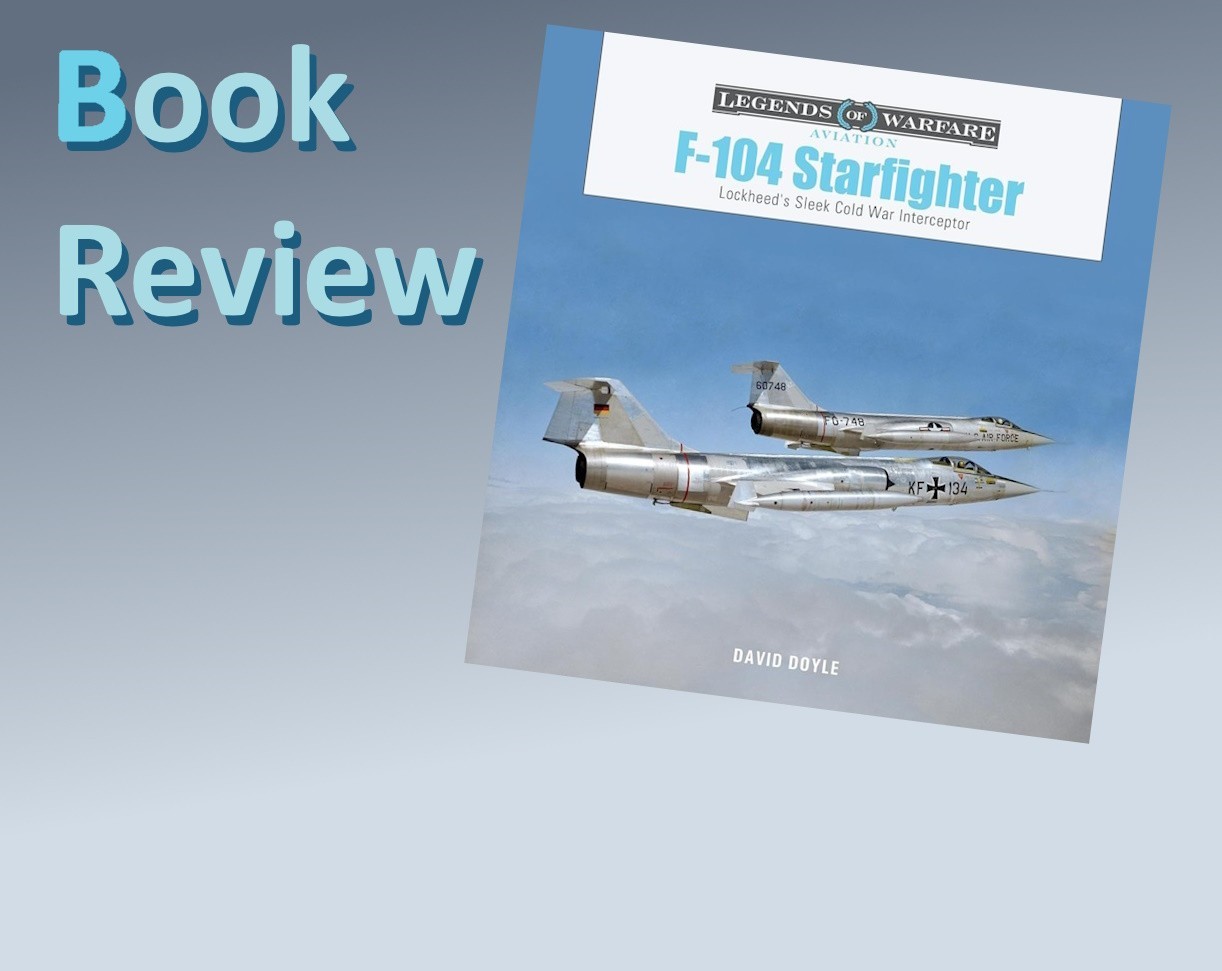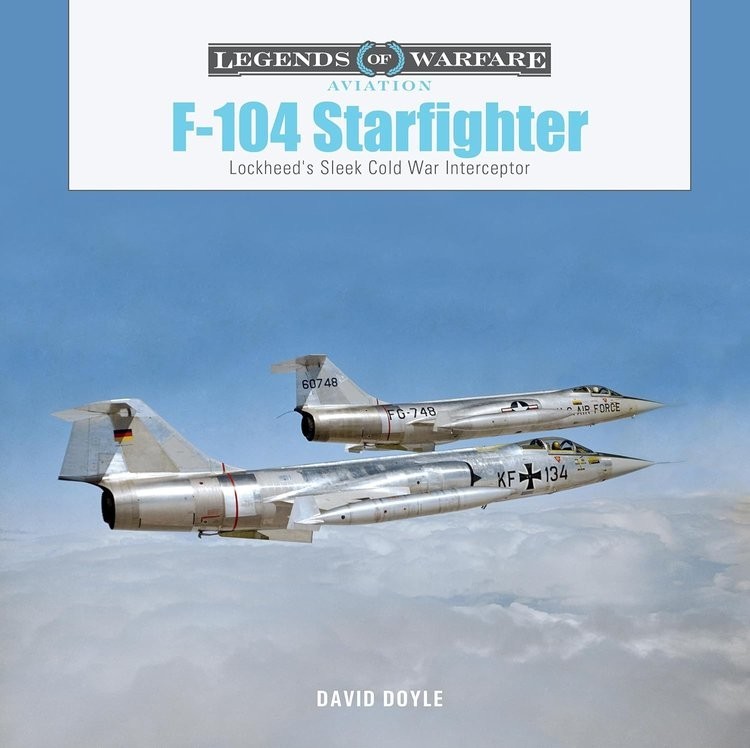
Introduction
F-104 Starfighter, Lockheed's Sleek Cold War Interceptor is a new title by David Doyle, part of Schiffer Publishing’s series "Legends of Warfare (Aviation)."
This pictorial book presents the F-104 from prototypes through the F-104S Super Starfighter. A 9"x9" hardback of 144 semi-gloss pages, packed with hundreds of color or black-and-white photographs, it is catalogued with ISBN 978-0-7643-6786-1. Schiffer Publishing, Ltd. published the book, which is also available at a discount from the author at DavidDoyleBooks.com.
Legends of Warfare is a series of books of standard size, layout, and range from 112 to 144 pages in length. This is my third look at the series which feature a clean look, are easy to read and thus facilitate learning. Whether your interest is modeling, history or restoration, the focus is on the evolution and variant details of the F-104.
The genesis of David Doyle Books began while restoring military vehicles, while at the same time working in a hobby shop. Thus, his keen emphasis on what so many people of those communities value about his work.
Content
To many fighter fans, the Starfighter is the perfect airplane. To many of its pilots, it still is. The Lockheed F-104 Starfighter is one of those shapes—let alone airplanes—that you don’t soon forget. The MiG-15 fighter (NATO code name "Fagot") was a shock to United Nations pilots during the Korean War. Lockheed consulted with F-86 pilots fresh from fighting those MiGs as to what they wanted to make the perfect fighter; initially designed to counter the fast and capable Soviet fighter, that goal changed and the F-104 was tasked as a high-speed interceptor aircraft tasked with destroying incoming Soviet nuclear-armed bombers in a “hot” nuclear war. That task required maximum speed and climb performance. As such, it was extremely fast; in fact, it was the first Mach 2-capable production fighter in USAF service. But even though it was designed to be an air superiority fighter, it was not exceptionally maneuverable, though some scholars today dispute that. History's third-ranking fighter ace, Gunther Rall, considered the F-104 the best clear-air mass air superiority fighter he ever flew. History's top fighter ace, Eric Hartmann, considered the F-104 "garbage."
This extreme performance came at a price. The short, stubby wings that gave it such record-breaking speeds resulted in an unusually high landing speed, necessitating a drogue chute to slow the aircraft down on the landing rollout. The T-tail was unusual for a jet aircraft and made high angles-of-attack risky because the wings could blank out the airflow over the horizontal stabilizer, effectively making the aircraft uncontrollable in pitch. The new German Luftwaffe suffered an atrocious accident rate with it and called it “witwenmacher” (the widowmaker) or sometimes “fliegender sarg” (flying coffin). (My personal favorite is “erdnagel”…essentially “tent peg.”) There were many reasons for their problems, one being they transitioned from the subsonic F-84 and F-86 directly into the Mach 2 monster. Eventually, they worked out flaws and the accident rate dropped; several other countries operated the F-104 with few accidents, i.e., Spain had no major accidents.
American pilots called it simply “the missile with a man in it,” an unimaginative name, but undoubtedly the most technically correct. (It was also called the "Zip", but not for the reason you would think.) The jet essentially became a missile sent to destroy incoming nuclear-armed bombers. It would undoubtedly have performed this task well.
Although the Starfighter’s USAF service was relatively short-lived, it continued in service with several foreign air forces well into the 1980s, usually built under license. The most numerous version, the F-104G, was operated by Germany as late as the early 1990s in a test capacity. Other notable users included Italy and Canada, with Italy flying it into the 21st century.
But what about this book? F-104 Starfighter is told through 10 chapters and an Introduction:
1. The First Starfighter: XF-104 (7 pages)
2. Service Test and Production Prototypes: YF-104 (7 pages)
3. The Starfighter Enters Service: F-104A (29 pages)
4. The Two-Seater Starfighter: F-104B (7 pages)
5. More Power: F-104C and D (30 pages)
6. The Starfighter for Everyone: F-104G (34 pages)
7. NASA Gets Its Own Starfighters: F-104N (5 pages)
8. The Canadian Starfighter: CF-104 (5 pages)
9. Built in Japan: F-104J (3 pages)
10. The Ultimate Starfighter: F-104S (5 pages)
The author presents not only the nuts and bolts history, he also includes archival information such as contract numbers and dates of signing, and explains how to decipher production block numbers, e.g., "F-104A-10-LO", and the original designation for air-to-air missiles. The beginning of the Starfighter was the XF-104, contracted as Weapon System 303A (WS-303A), signed March 1, 1953; the first flight of the XF-104 was March 4, 1954. What became of a pictured F-104 is often releated in the caption, if it crashed, scrapped, became a gate guard, retired, etc. The First Starfighter: XF-104 and Service Test and Production Prototypes: YF-104 tells the story of its developments and testing, and performance problems that led to adopting the legendary J79 jet engine, which in turn resulted in airframe changes. Also discussed are wingtip tank flutter, description of the inlets, and other visible changes.
The Starfighter Enters Service: F-104A presents much detail and information about the F-104, i.e., its surprisingly high G-capability. We learn of further improvements and enhancements, new equipment, and disappointments (J79 troubles). Mentioned is something I never considered - the effect of the pitot tube mounted in front of the radar. This chapter features many photos of F-104s deployed to Taiwan during a Red Chinese provocation. It also shows us QF-104 target drones.
The Two-Seater Starfighter: F-104B looks at the trainer version of the aircraft, pointing out additional airframe changes.
More Power: F-104C and D addresses adding all-weather capabilities, more offensive weapon pylons, fixing engine problems, new fire-control systems, and the result that the F-104 set some records. Photo captions convey interesting information about colors and markings, including special markings for war games. This chapter introduces use to USAF Starfighters at war in Vietnam. Modelers will find excellent photo references for the aircraft, colors and markings, bases, hardstands and revetments, and airfield equipment. These photos also show interesting camouflage wear patterns.
The Starfighter for Everyone: F-104G continues the same treatment as above: contracts; system redesigns/improvements; sales/licensing agreements to foreign customers. If you are familiar with the European air war of World War Two, you will encounter some familiar names: Messerschmitt; Focke-Wulf; Fiat; Fokker; BMW and others. We learn of the numerous air forces that flew the F-104 in Europe and the author points out different aircraft finishes of the F-104s for those countries at different times.
Next, NASA Gets Its Own Starfighters: F-104N delves into the aircraft in research. The tragedy of the collision with the XB-70 is mentioned, as well as the 104's role with the Space Shuttle. Some of the paint jobs cry out for modeling. The Canadian Starfighter: CF-104 presents Canada's role with the jet. It points out a change in the tail markings of Canada I never heard of before.
The shortest chapter is Built in Japan: F-104J. As in each chapter, we learn of the manufacturers, new equipment, and dates of operational use. Finally, The Ultimate Starfighter: F-104S tells of the most capable air-to-air F-104. Equipped with the J79-GE-19 engine NASARR R21-G/H radar, and more hardpoints, Italy enhanced it to carry radar-guided AIM-7 Sparrows, and Turkey acquired them, too.
Photographs, Graphics and Artwork
The gallery hosts seven pages with 24 walkaround close-ups of a display aircraft, as well as countless walkaround close-ups of operational F-104s. This includes the AR2-3 rocket of the NASA F-104Ns.
One incredible photos shows a crumpled "Zip" on its back alongside the runway, drenched with fire suppressing foam, the caption recounting the incredible future of that aircraft. Other photos I think modelers will find particularly interesting are:
- F-104A-1-LO 56-0734 in NASA markings: unique and remarkable colors on the nose, wings and tail of an otherwise bare metal '104. Shot from 10 O'clock high against the desert.
- F-104 with an unusual demarcation between the top and bottom of the fuselage.
- F-104s in an "air defense gray" scheme.
- Avionics panels and compartments opened up.
- Close-ups of the canopy areas and wingtips sans tanks or missiles.
- F-104s with "shapes" (practice nuclear bombs).
- CF-104s in formation with USN F-4Js.
Artwork
This book includes line art and color illustrations of F-104s.
1. Visible differences between the early and late YF-104s: profiles with specific visual characteristics.
2. F-104 Development: 10 profiles of each type of F-104.
3. F-104A and F-104B canopy difference.
4. F-104A/C and F-104B/D/G vertical stabilizer differences.
5. F-104B and F-104D canopy differences.
6. Jordanian F-104B color artwork profile.
7. Exterior differences between the F-104S and F-104G illustrated with line art.
8. Turkish F-104S color artwork profile.
Graphics
Table Data for the XF-104, F-104A, F-104B, F-104C, F-104G, F-104S:
- Crew
- Powerplant
- Dimensional data
- Wing area
- Weights
- Maximum and cruise speeds
- Rate of climb
- Service ceiling
- Normal and maximum ranges
- Flyaway cost
- Maintenance cost per flying hour
The captions are often very detailed and add a great deal to the images.
What a beauty
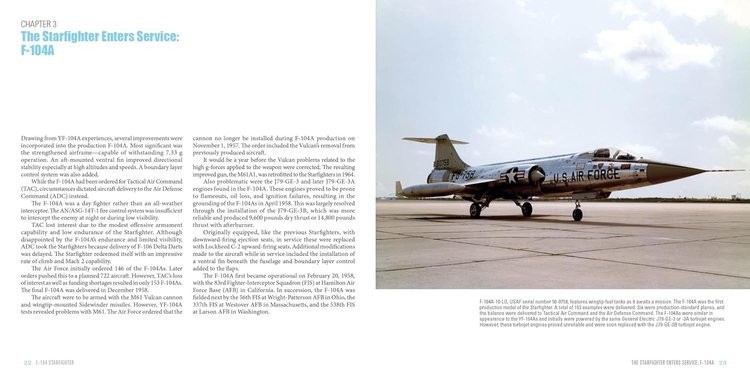
Starfighters from around the world
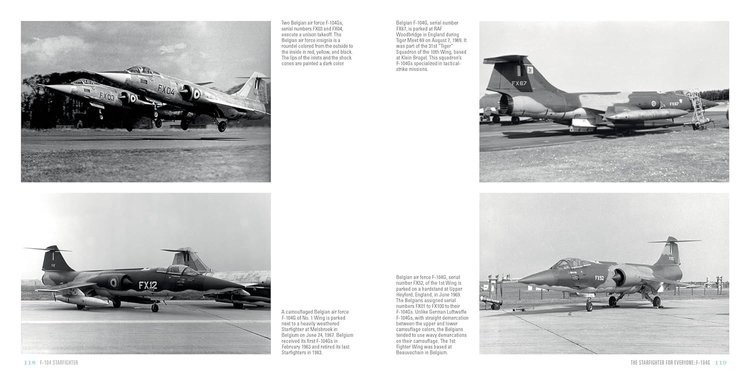
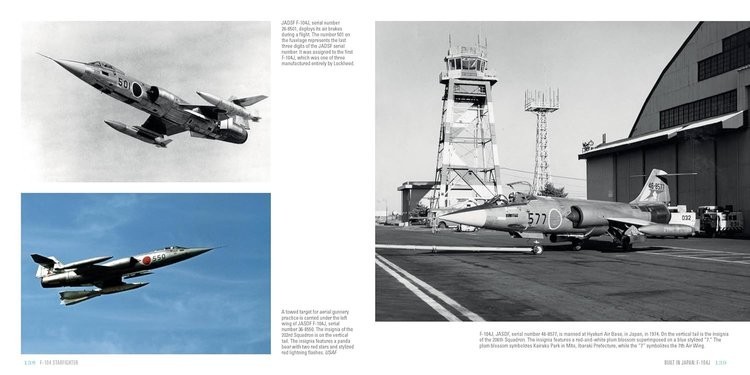
Flight of four "shape up"
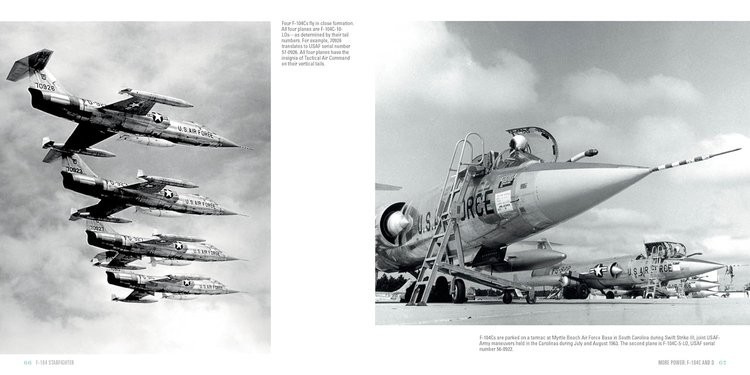
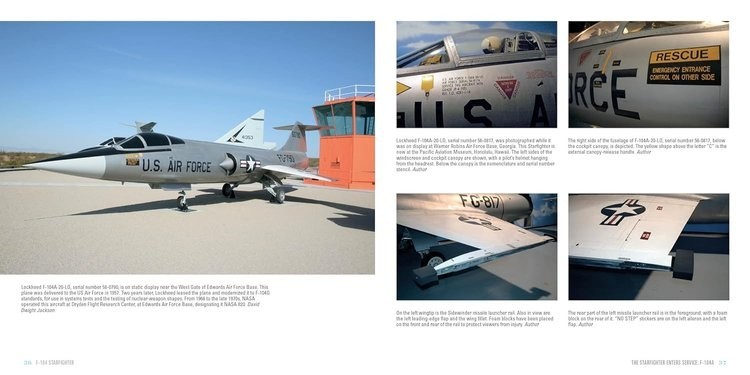
Conclusion
F-104 Starfighter is another sure-to-be hit for the Legends of Warfare (Aviation) range by Schiffer. Mr. Doyle provides a good history or the jet, and assembled an exceptional gallery of imagery to support the text. The detail line art is useful and the color plates capture F-104s not otherwise covered in detail, yet interesting. With a fighter that served so long with so many air forces, Mr. Doyle was no doubt constrained by book length, but I am was surprised that no Taiwanese or Pakistani F-104s were shown, especially as they flew the "Zips" that actually engaged in air-to-air combat and scored kills. I was also wondering if an alleged scoring dogfight between NATO members Greece and Turkey would be mentioned, if for no other reason than the surreal conflict between NATO partners.
Regardless, I think this is a wonderful resource for modelers of the legendary/notorious (take your pick) Starfighter. It shows the different variants, paint schemes, weapon load-outs, and many other aspects that modelers enjoy.
Recommended.
Please remember to mention to David Doyle Books, Schiffer Publishing, and retailers that you saw this product here - on Aeroscale.











